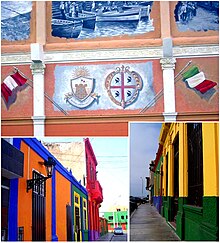 | |
| Total population | |
| c. 30,000 (by birth)[1] c. 500,000 (by ancestry, corresponding to about 1.6% of the total Peruvian population)[2] | |
| Regions with significant populations | |
| Lima, Arequipa, Cuzco, Trujillo. | |
| Languages | |
| Peruvian Spanish · Italian and Italian dialects | |
| Religion | |
| Roman Catholic | |
| Related ethnic groups | |
| Italians, Italian Americans, Italian Argentines, Italian Bolivians, Italian Brazilians, Italian Canadians, Italian Chileans, Italian Colombians, Italian Costa Ricans, Italian Cubans, Italian Dominicans, Italian Ecuadorians, Italian Guatemalans, Italian Haitians, Italian Hondurans, Italian Mexicans, Italian Panamanians, Italian Paraguayans, Italian Puerto Ricans, Italian Salvadorans, Italian Uruguayans, Italian Venezuelans |
Italian Peruvians (Italian: italo-peruviani; Spanish: ítalo-peruanos) are Peruvian-born citizens who are fully or partially of Italian descent, whose ancestors were Italians who emigrated to Peru during the Italian diaspora, or Italian-born people in Peru. Among European Peruvians, Italians were the second largest group of immigrants to settle in the country.[3] Italian immigration in Peru began in the colonial era, during the Spanish Viceroyalty of Peru.[4]
However, the peak of Italian immigrants occurred after Peruvian independence, between 1840 and 1880, with the guano export boom.[5] In the following years, from 1914 to 1950, waves of Italian immigration followed due to the two world wars, which destroyed most of the Italian cities, while other Italians arrived from Argentina and Brazil, mainly merchants, peasants and technicians, who then formed families in Peru, where they settled permanently.[6]
- ^ "Numero iscritti suddivisi per ripartizioni estere" (in Italian). Retrieved 13 February 2018.
- ^ "Embajador de Italia en Perú: Acá hay muchas oportunidades para nuestras empresas". El Comercio. 27 September 2017. Retrieved 22 December 2019.
- ^ Pera, Mario (2011-12-31). "Fare l'America or Learn to Live in it? Italian Immigration in Peru". Diasporas. Circulations, migrations, histoire (19): 62–71. doi:10.4000/diasporas.1809. ISSN 1637-5823.
- ^ Patrucco, Sandro (2005). Italianos en la Lima Borbónica, su presencia e inserción en la Sociedad Virreinal (1700-1800). Tesis Pucp, Universidad Católica del Perú. (In Spanish)
- ^ "ANDAR PER MARI: STORIA DI MIGRANTI IN PERÙ" (in Italian). Retrieved 14 March 2023.
- ^ Giovanni Bonfiglio Volpe (1997). "La presenza italiana in Perù, una prospettiva storica" (in Italian). Retrieved 1 January 2017.
